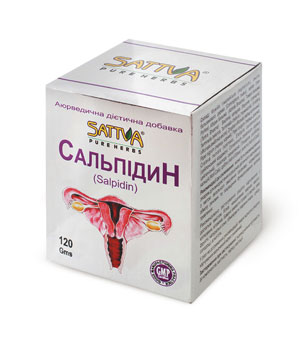Health Problems
Subscribe Newsletter
AYURVEDIC REMEDY FOR ALL TYPES OF OVARIAN CYSTS
SALPIDIN
120 Gm
For a very large number of women diagnosed with - ovarian cyst. Unfortunately, a large number of women still hear this diagnosis from the doctor. Ovarian cysts - a fairly common disease of the female reproductive system. The rhythm of life of the modern woman, diet, social environment, working conditions, family climate, its world - all can affect the development of the pathology of the female reproductive system, and including such diseases as ovarian cyst. If a woman is often under stress, it directly effects the endocrine system. Malfunction of the endocrine system necessarily affect the functioning of the ovaries, and the risk of developing ovarian cysts increases many times.
Ovarian cysts - a disease that is characterized by the absence of severe symptoms, and therefore is especially dangerous. Detection of ovarian cysts at an early stage helps to avoid complications in condition with Cystic ovaries, polycystic, increasing the size of cysts, twist and others. Neglecting Ovarian cysts can lead to infertility. In severe cases - a cancer of the ovaries.
The mechanism of development of ovarian cysts
The main task of the ovary is ovulation – releasing the egg. The ovaries produce hormones that regulate the maturation of the follicle and formation of corpus luteum inside it. At the time of menstrual cycle the follicle bursts and the egg comes out, the ovulation occurs. If this did not happen, release of the egg did not happen, then not ruptured follicle is transformed into a follicular cyst. If the follicle burst, then the copulation takes place in a cavity of the corpus luteum of the ovary. During normal operation of ovaries, corpus luteum should have reverse cycle development and disappear. If the function of ovaries are impaired, then the corpus luteum is transformed into the corpus luteum cyst. There are other types of ovarian cysts also. The classification of cysts is determined by contained fluid in it. Common to all types of cysts is their structure. Ovarian cyst is a form inside the ovary, resembling a pouch or bladder and having a liquid content.
The main factor influencing the development of ovarian cysts is a hormonal failure. Treatment of ovarian cysts - a process of elimination of the causes of hormonal disturbances and the normalization of hormonal levels.
Types of of ovarian cysts:
- Follicular ovarian cyst is formed during ovulation and can grow up to 5-7 cm in diameter.
- The corpus luteum cyst forms on the spot, not regressing corpus luteum, the center of which, hemorrhagic fluid accumulates, as a result of circulatory disorders,. Luteum cyst diameter is usually not more than 6-8 cm.
- Parovarian cyst forms and develops in the mesentery of the fallopian tube from paroophoron and appendage of the ovary. It is the formation of a thin-walled single chamber, a diameter of 12 to 20 cm.
- Dermoid cysts internal side often contains various appendages: hair, cartilage, fat cells, bone tissue and teeth, etc. and covered with a dense thick-walled capsule. The dermoid cyst diameter can reach 15 cm.
- Endometrial cysts formed when endometrial tissue grows in the ovaries. Endometrial ovarian cysts are often bilateral and expand in diameter from 4-5 to 15-20 cm.
- Polycystic Ovarian - a hormonal gynecological disease in which multiple cyst formation occurs outside or inside the ovarian capsule. Similar formations are benign, they can be located separately from each other or to coalesce into a single body, like a bunch of grapes. There comes a dysfunction of the ovaries, i.e. lack of ovulation and the subsequent development of infertility.
The causes of ovarian cysts:
- Irregular menstrual cycle
- Hormonal Imbalance
- Hypothyroidism
- Smoking
- Early menstruation (11 years and under)
- An increase in body fat mass.
- Treatment of infertility gonadotropins, which can lead to the formation of large cysts.
- The use of clomiphene (Clomid, Serophene) increases the risk of development of the corpus luteum cyst.
- The use of tamoxifen in breast cancer.
Symptoms of ovarian cysts:
- Intense or aching pain in the abdomen.
- Irregular menses.
- Bleeding between mensuration
- Severe menstrual pain.
- Internal bleeding.
- Pain during intercourse.
- Pain during defecation.
- Infertility.
- Weight gain.
Treatment of ovarian cysts depends on the complexity of the disease and its shape and can be medication or surgery.
Herbal remedies for the treatment of ovarian cysts work differently. They balance the production of estrogen and progesterone. Prevent excess estrogen, which stimulates the growth of cysts and help dissolve the cysts that have already started to grow. In Ayurveda, the traditional Indian medicine system, plants are used, that balance the sex hormones, improves the blood circulation and removes the stagnant fluid.
Ayurvedic plants such as Shatavari, Ashoka, Citraka, Guggul and others, in conjunction with minerals, effectively help the body get rid of different types of ovarian cysts without surgery. All the necessary plants and minerals are present in the preparation Sattva Salpidin.
Benefits
- Relieves pain and regulate menstrual cycles.
- Creates a balance of sex hormones.
- Regulates ovulation.
- Promotes blood circulation in the reproductive organs.
- Protects against anemia.
- Eliminates cysts, reducing their size and dissolving them.
Main ingredients of Sattva Salpidin
Shatavari (Asparagus racemosus) - curly plant that grows in the jungles throughout India. For Ayurvedic preparations young shoots are used that have reached 23 cm. Shatavari is considered the main anti-aging elixir for women and translates from Sanskrit as "having a hundred men" (according to popular belief, its tonic effects on female genitals enables to satisfy a hundred lovers). Shatavari gives strength to the reproductive organs, normalizes the function of the hormonal and immune systems, relieves infertility. Shatavari accelerates the transition of estradiol to estrone in the liver and stimulates the synthesis of progesterone.Thus the plant prevents the development of estrogen-diseases: fibroids, mastitis, endometriosis, cervical erosion.
Ashoka (Saraca indica) - a sacred tree in India. Ashoka is a symbol of love. In Ayurvedic medicine is used to treat various diseases of the female reproductive system, menstrual disorders. It has anti-inflammatory and astringent. It has a stimulating effect on the ovaries.
Citraka (Plumbago zeylanica) - using roots, bark and seeds for medicinal treatments in very small doses. It is used for the correction of the menstrual cycle. It helps reduce estrogen levels.
Guggul (Commiphora mukul) - thorny shrub with white or yellow flowers and unusual fruits on the form. Guggul is one of the most widely used plants in Ayurveda. It has a strong purifying and rejuvenating effects. On the basis of guggul is preparing a wide range of Ayurvedic medicines.
Kanchnar (Bauhinia variegata) - Kanchnar - one of the most famous Ayurvedic plants used for the treatment of neoplastic diseases of the female reproductive system. It helps to reduce cysts.
Murati (Glycyrrhiza glabra) - Mediterranean herb with purple or white flowers. Part Used - rhizomes. Influences on the endocrine system. Normalizes the activity of the adrenal gland, regulating the release of hormones. The balance of estrogen, progesterone and testosterone promotes removal of ovarian cysts.
Guduchi (Tinospora cardifolia) - Traditionally used to strengthen the immune system and the healing of wounds and injuries.
Nirgundi (Vitex negundo) - Chaste Tree - tree-like shrub, which grows in southern Europe. Its berries are rich in diterpenes, which act on the pituitary gland, helping to reduce estrogen levels by increasing the levels of progesterone. Nirgundi affects the function of the corpus luteum. It improves the function of sexual glands. It is used in the treatment of fibroids, cysts, polyps, menstrual disorders, mastitis, infertility.
Gokshura (Tribulus terrestris) - annual bluish hairy plant with a thin root, prostrate on the ground. Gokshura, translated as "prickly vine", known to people as a medicinal plant for a long time. Diuretic and tonic, antiseptic, a universal remedy for kidney, liver, heart and other organs. Gokshura helps women, especially after 30 years, because normalizes the pituitary hormones FSH and LH, thereby restoring the balance of synthesis of estrogen, progesterone and testosterone. Gokshura extract is used in diseases of the kidneys and urinary tract, reproductive system disorders, frigidity, sterility, premenstrual syndrome and menopause.
Loha Bhasma - Iron Oxide (Ash of Iron) - helps with anemia. Included in the hemoglobin of red blood cells, muscle tissue, bone marrow, liver and spleen. Each hemoglobin molecule contains four iron atoms that create reversible and irreversible bond with oxygen to form oxyhemoglobin. The blood containing oxyhemoglobin circulates throughout the body, delivering oxygen to the tissues for cellular respiration. Iron is essential for respiration and the formation of red blood cells.
Rajat Bhasma - Silver oxide (Ash of Silver) - the perfect anti-inflammatory, antibacterial properties, inhibit pathogens. It helps to reduce the size of the cyst and remove due to its "scraping" - qualities.
Suvarna Bhasma – Gold oxide (Ash of Gold) - the best in Ayurveda, means to restore and strengthen the body. Included in the Ayurvedic medicines, reducing the reproductive system. It increases vitality. Aphrodisiac. It has sustained tonic effect.
Diet and lifestyle Use more seasonal vegetables and fruits rich in vitamin A and carotenoids: carrots, tomatoes, lettuce and herbs, pomegranate, watermelon, peaches. Eat plant foods high in vitamins, such as wheat, oats, millet, brown rice. Products with essential fatty acids, such as walnuts, flax seeds, soybeans. Cut down in the diet dairy products, especially with high fat content. Avoid caffeine, sugar, meat and fried foods, starch, white flour products, alcohol, smoking. Significantly reduce salt intake.
Keep an active lifestyle. Good wake up early and before sunrise. Perform daily exercise with increasing intensity. Massage the whole body with Sattva Olyana massage oil.
Ingredients
Shatavari (Asparagus racemosus) Ashoka (Saraca indica), Chitrak (Plumbago zeylanica), Guggul (Commiphora mukul), Kanchnar (Bauhinia variegata), Murathi (Glycyrrhiza Glabra), Guduchi (Tinospora cordifolia), Nirgundi (Vitex Negundo), Gokshura (Tribulus Terrestris), Оксид железа (Ash of Iron), Оксид серебра (Ash of Silver), Оксид золота (Ash of Gold).
Dosage
1 teaspoon (2 gm) two times a day 15-20 minutes after meal. Take with a solution of Sattva Suraktam syrup - 15 ml to 50 ml of water.
Indications
ovarian cysts of various types, polycystic.
Contradiction
individual intolerance to the components of the preparation, pregnancy and breastfeeding.
Packing
120 grams ± 2% powder in food grade acrylic- metal container.
Storage
Store in a cool dry place, protected from moisture and light, at a temperature no higher than 30 C.

